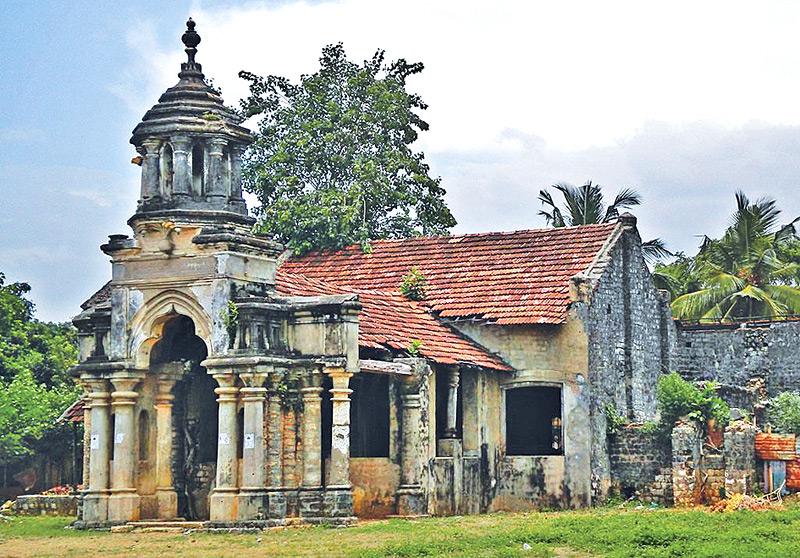
Jaffna has a long history dating back to the Tamil kings who ruled the Jaffna kingdom then. However, not much evidence is available save for a few Tamil inscriptions found unearthed and some ruins scattered in the district. Today, these places are popular tourist attractions that draw visitors from the south as well as from foreign countries. After the end of the war and the establishment of peace in the country, more and more local and foreign tourists started visiting the Northern Province.
 The Dutch Fort located in the centre of the city is a popular venue among the sightseers to the peninsula. The Jaffna museum, the Nilawara bottomless well, Kandarodei temple, Jaffna library, Nallur Kovil, Kareinagar beach, Casuarina beach, Keerimalai, Nagadeepa, Dambakola Patuna and the Buddhist temple are some of the places of attraction. However there is one landmark in Jaffna, which only a few are aware of.
The Dutch Fort located in the centre of the city is a popular venue among the sightseers to the peninsula. The Jaffna museum, the Nilawara bottomless well, Kandarodei temple, Jaffna library, Nallur Kovil, Kareinagar beach, Casuarina beach, Keerimalai, Nagadeepa, Dambakola Patuna and the Buddhist temple are some of the places of attraction. However there is one landmark in Jaffna, which only a few are aware of.
Located a kilometre from the Nallur Kovil, it is called ‘Manthiri Manai’. In Tamil ‘Manthiri’ means minister and ‘Manai’ is abode, and thus it came to be known as ‘Minister’s Abode’. It is a magnificent old building, one of the few surviving structures associated with the Jaffna kingdom. Legend has it that a certain minister of a Tamil king called Cankili who ruled the Jaffna kingdom before the arrival of the Portuguese had lived in this palace, and hence the name Minister’s Abode.
This historic building situated along the Nallur – Point Pedro road, could be located easily and is clearly visible from the main road. Built on a half acre land, there are two gateways to enter the premises – one, an arched porch built during ancient times and another gate built recently. This centuries old massive mansion standing majestically facing the road, seems to have stood the test of time.
The building complex surrounded by other residences, has an eerie atmosphere, bleak and desolate inside, looks like a ghost abode. A few other historical remains nearby – the Sattanathar temple, Yamuna Eri and Cankillian Thoppu are also considered as remains of the ancient Jaffna kingdom. The recently constructed gold plated statue of king Cankili and the palace arch are visible sights along the main road. The Yamuna Eri or Yamuna pond, believed to have been a favourite bathing spot of the queen lies behind the palace.
The building is a blend of European and Dravidian architecture. At the entrance is an ornamental gateway, a large arched porch and a tower. It is a two storey building supported by massive brick walls and wooden rafters. The interior walls are decorated with beautiful wood carvings. The walls coated in white paint, have faded with time. Walking from room to room I found a well, around 12 - 15 feet deep attached to one of the rooms in the building and also a concrete wash basin. The water in the well seems crystal clear.
There is a staircase leading to a few underground rooms, and cellar in a separate section. It consists of hidden underground tunnels, may be to escape in case of a sudden enemy attack. Now, the building is in a dilapidated state, some parts crumbling and disappearing, and water leaking through the broken tiles of the roof.
Though it is believed to be the abode of a king’s minister, it is still shrouded in mystery as various contradictory views have been expressed on its origin. Some historians say this building was either renovated or newly built by the Dutch during their period. Some are of the opinion that it has no connection whatsoever with the Jaffna kingdom, but is a choultry built in the 19th century.
The structure is built with bricks, lime plaster, wood and tiles, materials used by the Dutch for the construction of their ramparts and other buildings. Hence, Dutch influence could largely be seen in the crumbling façade of the building.
However, the ornamental work on the pillars and the arched porch seem to belong to the Jaffna kingdom. There are various theories regarding this historical monument, and we are unable to state exactly who built this and for whom. Now the Government of Sri Lanka has listed it as an archaeologically protected monument.
